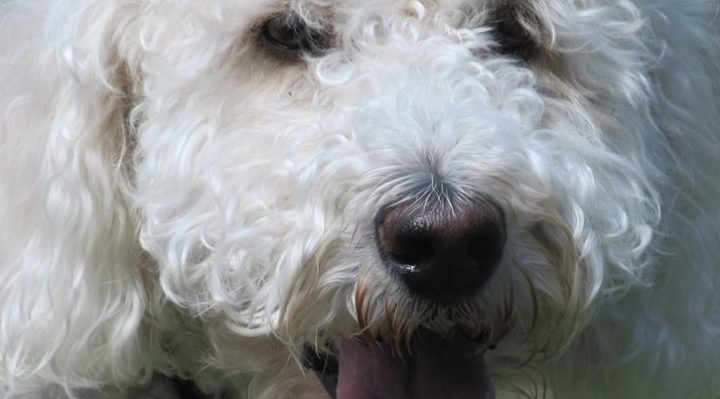
Three hazards that pet-loving people should avoid: fidget spinners, flexi-leashes, and marrow bones. Is there a pet in your home? Put these three hazards on your list of Not In My House!
What’s a fidget?
A fidget spinner is a type of stress-relieving toy. A basic fidget spinner consists of a bearing in the center of a design made from any of a variety of materials including brass, stainless steel, titanium, copper and plastic. The toy has been advertised as helping people who have trouble focusing or fidgeting (such as those with ADHD, autism, or anxiety) by acting as a release mechanism for nervous energy or stress. Experts were divided on this claim, with some supporting it while others disputed its scientific basis and argued the toy may actually be more distracting. Although they were invented in the 1990s, fidget spinners became a popular toy in 2017. Often marketed with health benefits, the toy began being used by school children, resulting in some schools banning the spinners, arguing that the toy became a distraction in classrooms. Other schools are allowing the toy to be used discreetly by children in order to help them concentrate. —Wikipedia
Teachers I know don’t like fidget spinners, at least not in their classrooms, but fidget spinners are everywhere that American children go—which is why I’m giving you this warning. I suggest you Google “fidget spinner X-rays” or “injuries from fidget spinners” for some very graphic examples of how this toy has caused pain, injury, and the resulting extensive and expensive medical treatment to humans.
You can probably imagine, then, what uncomfortable results this little “stress-reliever” can cause when it’s played with by a dog. That’s right—it can be very dangerous. Dogs can bite it, chew it, swallow it (or pieces of it). They can break teeth, gouge gums, choke and possibly die from attempting to ingest it. That might even happen to a cat or a ferret or a bird. Many pets find this little object almost irresistible.
Don’t let a fidget spinner injure your pet. Set some rules that you know family members will follow about where and when they can play with their spinners . . .and, most important, about their responsibility for keeping the family pets (and little brothers and sisters!) safe from the potential health hazards of fidget spinners left where claws, paws, and tiny fingers can reach.
Praise and reward the kids for following the rules, of course, but police the area yourself as well. These are not toys with which any pet should interact.

What’s a flexi-leash?
A retractable leash is not so much a leash as it is a length of thin cord wound around a spring-loaded device housed inside a plastic handle. The handles of most retractable leashes are designed to fit comfortably in a human hand. A button on the handle controls how much of the cord is extended.
—Marty Becker, DVM
Retractable flexi-leashes have been popular for some years, and most dog owners have no idea that what seems to be a very useful tool can be instead a very dangerous object. We’re enchanted by the idea that our dog, on a flexible lead, has more freedom when walking than may be offered by a more confining standard leash. We do not know what the cost of that freedom will be until it happens to us, and then it is too late.
Here’s a short excerpt from a story on flexi-leashes by ABC News:
It was a shocking sight for a mother—a piece of metal sticking out of her 12-year-old’s eye.
That’s what Joy Williams saw after her daughter Dereka was injured last year when a retractable dog leash broke and the metal clasp snapped her in the face.
“She was like, ‘Mom, I can’t see! I can’t see!’” Williams told ABCNews.com.
http://abcnews.go.com/Health/story?id=7058784&page=1
Consumer Reports tells another horror story about flexible retractable leashes:
Heather Todd lost a portion of her left index finger in a Flexi retractable leash accident in 2005. Her yellow Labrador retriever, Penny, was hooked to a friend’s retractable leash when the dog became excited. The 90-pound dog bolted after something and Todd said she lost control of the handle, which caused the cord to burn her arm. When she instinctively tried to brush the cord off her arm, Todd said her finger got caught and she was pulled to the ground and dragged for four or five feet.
“I look up and there’s a finger tip right in front of me,” she said, adding that she was in such shock she at first thought the finger was a child’s Halloween-type toy. “I didn’t comprehend, ‘Oh, Heather, there’s your fingertip lying there in the sand.’”
Do you own a flexible retractable leash that’s never given you any problems? Consider these important points from Dr. Marty Becker. A flexi-leash is not a good training tool.
10 Reasons Not to Use a Retractable Leash
Please, consider replacing the flexi-leash with a long line and use the long line instead:
https://www.youtube.com/watch?v=Jq9PmWPspfk
What’s a marrow bone?
It’s a bone containing marrow! The marrow bones that are causing problems for dogs are a circular shape, with the marrow in the middle. They vary in size, usually from about four to six inches in diameter. They’re an inexpensive chewing object for dogs, who gnaw and lick to get out all the marrow.
Unfortunately, because of the particular shape of the popular round marrow bones, they can be extremely dangerous for dogs . . . because the bone can get caught around the dog’s teeth and lower jaw. When that happens, the usual next step is a trip to the veterinarian—if anyone is around to save the dog, that is. Once at the veterinary clinic, the dog must be sedated and a bone saw must be used.
Here’s a veterinarian from Kimberling Animal Hospital in Kimberling City, MO, treating a dog with a marrow bone stuck around its lower jaw:
https://www.youtube.com/watch?v=qXPaKIsZfFo
Don’t take a chance.
- Supervise your dog whenever he has a bone.
- Put the bone away in a safe place when your dog has finished chewing on it.
- Do not leave bones accessible to dogs that are not supervised.
- Do not give your dog round marrow bones.
- Ask your veterinarian what bones are safe for your dog to chew, and take your veterinarian’s advice.
Want to know more about rewarding your dog for making good choices? I will be teaching a free class in Spokane next month and, if you’re in the area, I hope you will attend!
DOGS—LIVING WELL WITH YOUR BEST FRIEND
Monday, June 5, 2017, 6:30–7:30 p.m.
South Hill Library, 3324 South Perry Street, Spokane, Washington 99203
Families, school-age kids (K–5th grade), tweens (5th–8th grade), teens (13–18 years), adults
Dog training is no longer a matter of punishment, force, and fear. Today’s dogs learn to make the right choices because they’re trained with positive, force-free methods that shape their behavior with rewards. What is rewarding to your dog? Val will help you to figure that out! Do you have concerns about your dog’s care and feeding, manners, bad habits or anxieties? Val will be available to answer your questions before class, from 5:30–6:30 p.m., so join us early if you can! Families are welcome.
http://www.spokanelibrary.org/calendar/?trumbaEmbed=view%3Devent%26eventid%3D123527681



